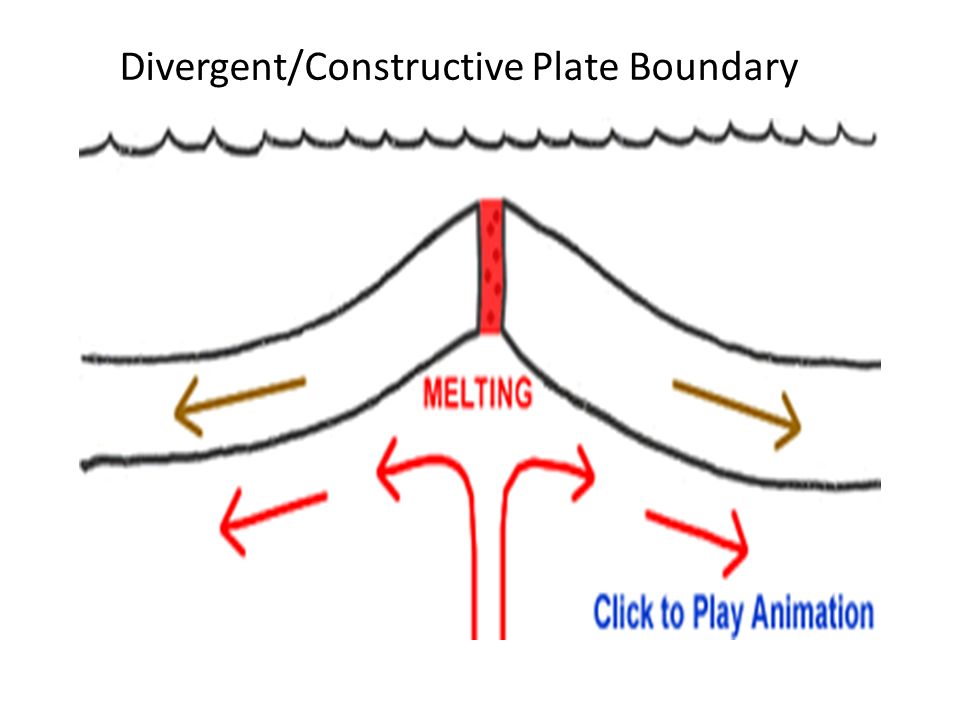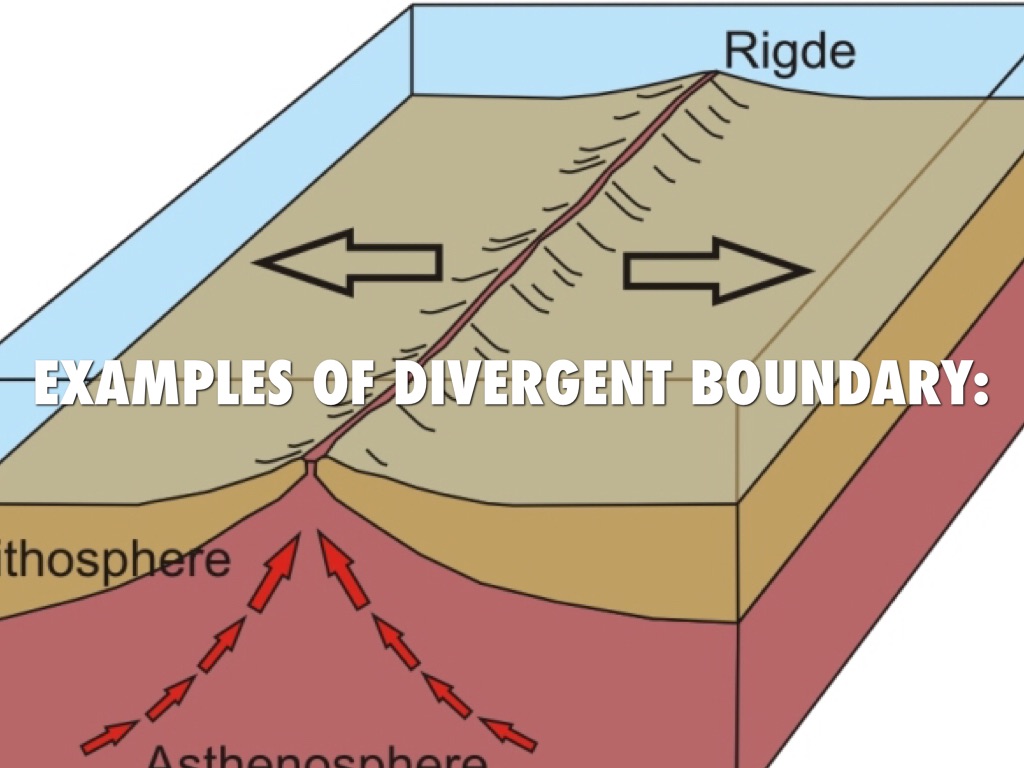Divergent Boundary Drawing
Divergent Boundary Drawing - In locations where lithospheric plates are diverging, the rates of divergent motion range from 2 to 17 cm/year. As shown in the drawing above, when earth's brittle surface layer (the lithosphere) is pulled apart, it typically breaks along parallel faults that tilt slightly outward from each other. Divergent (i.e., moving apart), convergent (i.e., moving together), and transform (moving side by side). In the western part of the continent, divergent plate boundary forces are beginning to rip the continent apart, forming the basin and range province and its adjacent eastern arm, known as the rio grande rift. Divergent boundaries (in geology) occur when tectonic plates—immense, rigid pieces of the earth’s lithosphere—move apart, or diverge. Plate boundaries can be categorized in three fundamental types: Web visit the interactive plate boundary map to explore satellite images of divergent boundaries between oceanic plates. Web boundaries between the plates are of three types: Web like other continents, north america has thick crust, compared to the thin crust beneath the adjacent atlantic and pacific oceans. Volcanoes are also often found near plate boundaries because molten rock from deep within earth—called. Volcanoes are also often found near plate boundaries because molten rock from deep within earth—called. Web volcanoes occur at divergent margins (where magma rises and erupts); Plate boundaries can be categorized in three fundamental types: This is one of the main. Web convergent boundaries, also called destructive boundaries, are places where two or more plates move toward each other. Web convergent boundaries, also called destructive boundaries, are places where two or more plates move toward each other. Divergent boundaries are spreading boundaries, where new oceanic crust is created to fill in the space as the plates move apart. The di in divergent comes from a latin prefix meaning apart, so divergent boundaries happen where two tectonic plates move apart.. In the western part of the continent, divergent plate boundary forces are beginning to rip the continent apart, forming the basin and range province and its adjacent eastern arm, known as the rio grande rift. Divergent boundaries are spreading boundaries, where new oceanic crust is created to fill in the space as the plates move apart. This is one of. Divergent boundaries are spreading boundaries, where new oceanic crust is created to fill in the space as the plates move apart. As shown in the drawing above, when earth's brittle surface layer (the lithosphere) is pulled apart, it typically breaks along parallel faults that tilt slightly outward from each other. Web convergent boundaries, also called destructive boundaries, are places where. In locations where lithospheric plates are diverging, the rates of divergent motion range from 2 to 17 cm/year. Web types of plate boundaries. No views 1 minute ago. Divergent (i.e., moving apart), convergent (i.e., moving together), and transform (moving side by side). Featuring the ridge, lithospheric plate composition, density and. Along these boundaries, earthquakes are common and magma (molten rock) rises from the earth’s mantle to the surface, solidifying to create new oceanic crust. Web updated on january 17, 2020 divergent boundaries exist where tectonic plates move apart from each other. As shown in the drawing above, when earth's brittle surface layer (the lithosphere) is pulled apart, it typically breaks. When earth’s tectonic plates grind past one another, enormous amounts of energy can be released in the form of earthquakes. Web volcanoes occur at divergent margins (where magma rises and erupts); Web in plate tectonics, a divergent boundary or divergent plate boundary (also known as a constructive boundary or an extensional boundary) is a linear feature that exists between two. This is one of the main. Web divergent boundaries are spreading boundaries, where new oceanic crust is created to fill in the space as the plates move apart. Web what are divergent boundaries? Web like other continents, north america has thick crust, compared to the thin crust beneath the adjacent atlantic and pacific oceans. (a) divergent boundaries, where plates separate. Web students can follow along and draw divergent boundaries, adding vocabulary terms like asthenosphere, lithosphere, convection current, crust, magma, molten ma. In the western part of the continent, divergent plate boundary forces are beginning to rip the continent apart, forming the basin and range province and its adjacent eastern arm, known as the rio grande rift. Convergent boundary movement is. Unlike convergent boundaries, divergence occurs between only oceanic or only continental plates, not one of each. Divergent (i.e., moving apart), convergent (i.e., moving together), and transform (moving side by side). Web volcanoes occur at divergent margins (where magma rises and erupts); Web convergent boundaries, also called destructive boundaries, are places where two or more plates move toward each other. Divergent. Web divergent boundaries are spreading boundaries, where new oceanic crust is created to fill in the space as the plates move apart. Web visit the interactive plate boundary map to explore satellite images of divergent boundaries between oceanic plates. Web another kind of plate movement is called a divergent boundary. Divergent boundaries (in geology) occur when tectonic plates—immense, rigid pieces of the earth’s lithosphere—move apart, or diverge. Featuring the ridge, lithospheric plate composition, density and. No views 1 minute ago. Volcanoes are also often found near plate boundaries because molten rock from deep within earth—called. Magma forms in the continental plate above the diving oceanic plate), and less commonly as hot spots (where magma melts through a plate, such as hawai`i). Web a divergent boundary occurs when two tectonic plates move away from each other. This is one of the main. Drawing & annotating a diagram of a divergent plate boundary. As shown in the drawing above, when earth's brittle surface layer (the lithosphere) is pulled apart, it typically breaks along parallel faults that tilt slightly outward from each other. Convergent boundary movement is divided into two types, subduction and collision, depending on the density of the involved plates. Web at divergent boundaries, sometimes called constructive boundaries, lithospheric plates move away from each other. Divergent (i.e., moving apart), convergent (i.e., moving together), and transform (moving side by side). Web updated on january 17, 2020 divergent boundaries exist where tectonic plates move apart from each other.
Divergent Boundary Definition & Examples Video & Lesson Transcript

divergent boundary
/GettyImages-483766933-56c6e7fd3df78cfb37869a63.jpg)
Divergent Boundaries

Divergent boundary Wikipedia

Divergent Boundary Sketch at Explore collection of

divergent boundary

divergent Boundary
Divergent Boundaries Tectonics Website

Divergent Boundary Sketch at Explore collection of

Divergent boundaries the tectonic forces that split the earth
Web Boundaries Between The Plates Are Of Three Types:
Web Students Can Follow Along And Draw Divergent Boundaries, Adding Vocabulary Terms Like Asthenosphere, Lithosphere, Convection Current, Crust, Magma, Molten Ma.
Along These Boundaries, Earthquakes Are Common And Magma (Molten Rock) Rises From The Earth’s Mantle To The Surface, Solidifying To Create New Oceanic Crust.
Divergent Boundaries Are Spreading Boundaries, Where New Oceanic Crust Is Created To Fill In The Space As The Plates Move Apart.
Related Post: